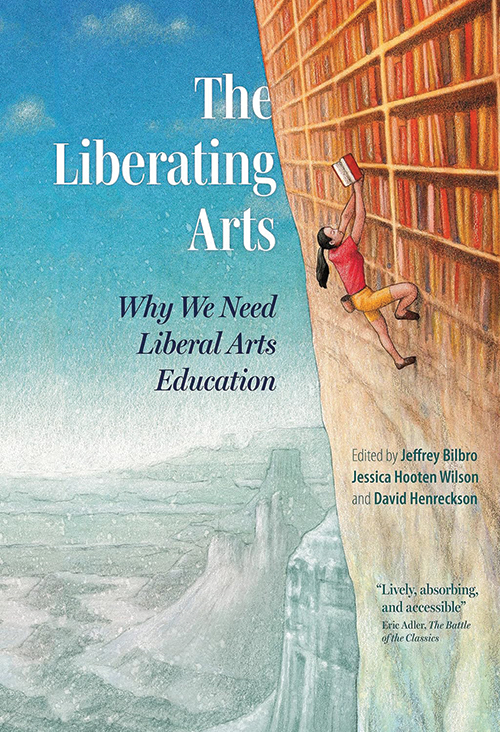
The Liberating Arts: Why We Need Liberal Arts Education
Reviewed by Carl Blumenthal
April 1, 2024
Edited by Jeffrey Bilbro, Jessica Hooten Wilson, and David Henreckson. Plough Publishing House, 2023. 224 pages. $59.95/hardcover; $19.95/paperback; $9.99/eBook.
I started premed in college, then consecutively switched my major to philosophy, history, geography, and psychology before finishing with comparative literature, earning a bachelor’s and master’s from Clark University in Worcester, Mass. With a combination of my parent’s financial aid and a scholarship, I was fortunate enough to emerge from this educational cocoon debt-free.
After careers as a community organizer, urban planner, and journalist, I’m now a mental health peer counselor and a writer. Did the liberal arts liberate me to be all that I can be and still earn a living? Hell yes! And heaven help my wife and our three cats who now depend on my largesse to feed them. Thanks to my liberal arts education, at age 72, I greet every sunrise eager to learn something new about the mystery of life, liberty, and the pursuit of happiness for those of us who are privileged in the United States of America.
But in this contemporary world of specialization, where AI, such as ChatGPT, eliminates the need to know how to write or to know anything outside the domain of our jobs, a book about the need for the liberal arts is either hopelessly archaic or just the antidote the soul doctor ordered for our screen-obsessed, oblivious times.
The Liberating Arts began as an online dialogue during the COVID pandemic among faculty of small, Christian liberal arts colleges, such as Abilene Christian University, Wheaton College, Whitworth University, St. John’s College, Calvin University, and George Fox University. Some of these professors were either laid off, fired, or transferred to other schools, if they didn’t leave teaching altogether. This literary effort to justify their existence is clearly personal, but they avoid blaming their schools, no doubt to assure their professional survival. Unfortunately, such an omission undercuts their case for a balanced “way forward” for the liberal arts.
The questions that form each of the ten chapters’ titles deliberately respond to widely held perspectives about the value of the liberal arts—from “What Are the Liberating Arts?” to “Aren’t the Liberal Arts Just for Smart People?”—and the contents that follow have preordained, affirmative answers. (So too am I biased by my success story to declare we need the liberal arts now more than ever.) But just as I learned the liberal arts’ triumvirate of virtues consists of critical thinking, moral judgment, and artful communication, I must caution readers that all liberal arts crusaders are not created equal, that is, equally proficient.
Here we have academics who trip over their abstractions as well as those who ground their theories in practice, theologians who obfuscate as well as liberate, and artists who tell (too much) as well as show (too little). Nevertheless, I enjoyed many of the essays by the 25 contributors, such as “Practicing the Liberal Arts in Prison”; “The Odyssey Project”; “Art Matters”; “Why Engineers Need the Liberal Arts”; “Liberation from Lonely Suffering and Death”; and “Small Magazines as Educational Communities.”
Particularly apropos of the current intellectual and ideological divisiveness on campuses is Joseph Clair’s “Truth U, Justice U, Jesus U,” in which he emphasizes a third vision of liberal arts outside of the binary framework of two approaches: the “liberal” Truth U schools and the “progressive” Social Justice U schools (based on the work of NYU social psychologist Jonathan Haidt). A professor at George Fox University, Clair muses, “The telos of Jesus U is love,” and he continues:
Here the love of learning is tethered to love for God, love for neighbor, and a healthy self-love. . . . The social-science caricature of the human person found in both Truth U and Social Justice U amounts to a reduction of human desire to either bare economic self-interest or raw social power. Neither gets to the true depth of human personality.
Being a mind-body-spirit evangelist and a mental health counselor, I want to ease the anxieties of younger readers of this review. If they and their parents and grandparents haven’t already incurred large debts to complete their liberal arts degrees, according to Richard A. Detweiler’s 2021 study, “The Evidence Liberal Arts Needs: Lives of Consequence, Inquiry, and Accomplishment,” such education prepares graduates “to reach higher incomes over the course of their careers as well as to advance to more prestigious positions within their fields.”
So perk up, Quaker pilgrims! In your pursuit of the truth, the good, and the beautiful—taking as many art history courses as courses on artful game design—you can earn enough to take care of number one as well as the numbers eight billion and counting who will weigh ever more heavily on Mother Earth if you don’t help lift them up. (This is the proverbial cake we all need to have and eat too, if not on a silver platter then on safe and sacred ground.)
Carl Blumenthal is among the many liberal, if not liberating, artists of Brooklyn (N.Y.) Meeting.



Comments on Friendsjournal.org may be used in the Forum of the print magazine and may be edited for length and clarity.